Proteomics Shared Resource Facility
Our facility provides comprehensive proteomic analysis services using state-of-the-art equipment, including:
- Advanced electrophoresis systems
- Modern imaging equipment
- Robotic sample handlers
- Mass spectrometers
We offer cell lysis of cell pellets or protein extraction from cells, protein quantitation, protein preparation (precipitation). Following protein preparation from cells or tissue, protein separation services using 1D or 2D-PAGE techniques are available. The gels can be stained with various stains including Coommassie, Sypro Ruby, Deep Purple and Silver. Multiplex analysis by visualization of proteins and protein modifications using specialized fluorescent stains, and advanced gel image analysis are available to study phosphorylation, glycosylation and other modifications. Changes in protein expression levels are analyzed using Differential Image Gel Electrophoresis (DIGE) which uses cy dye labeling.
